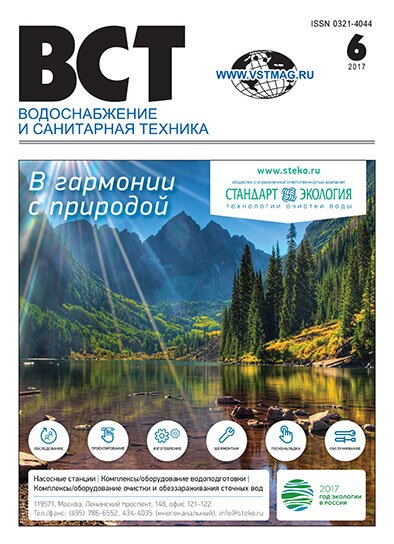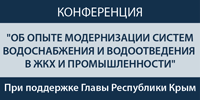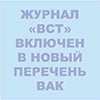|

Number 6 / 2017
To download all number in format PDF (in Russian)The further text is accessible on a paid subscription.
For authorisation enter the login/password.
Or subscribe
Number maintenance (pdf) (doc)
Number abstract (doc)
Literature lists to articles (doc)
|
bbk 000000
UDC 627.8:628.1
Volosukhin Ia. V., Navolokin D. Iu.
Ensuring the safety of water use in the Republic of Crimea
Summary
The water projects of the Republic of Crimea are defined as the sources of public water supply. The information on the state of the hydraulic engineering structures is presented. The owners and operators together with the supervisory authorities have inspected the hydraulic engineering structures with the purpose of further certification of their safety. By July, 2016 the authorities of Rostekhnadzor have approved 13 Declaration of Safety Certificates. In the process of certification the current state of the structures, operation service stuff was evaluated; possible scenarios of accidents, the risks of their occurrence and possible consequences were considered. For the hydraulic engineering structures operated in a continuous manner the generic solutions are developed for installing additional control and measuring equipment to monitor the seismic attributes as well as software package for immediate processing of the obtained data. Based on the results of the inspection the measures were scheduled in order to improve the safety of the structures, the time periods of their execution were determined compulsory for the owners and operators.
Key words
artesian water intake , water use safety , reservoir , hydraulic engineering structures , river flow
|
| Read more... |
bbk 000000
UDC 628.165
Pervov A. G., Andrianov A. P., Spitsov D. V., Efremov R. V.
Utilization of reverse osmosis concentrate with removing from it calcium and magnesium ions
Summary
The possible use of pre-developed technology of removing calcium carbonate with seeding agent to reduce the consumption of concentrate from large-scale units operating at the heat power facilities was studied. Concentrate of the operating reverse osmosis units contains inhibitors that inhibit the rate of seed crystal growth and impede the process of its utilization. The correlations between the calcium carbonate growth rate in the concentrate containing inhibiting substances and the dosage of the introduced seed, pH value and permeate yield were studied. For the implementation of the technology membrane apparatus with open channels are used that are resistant to the impact of membrane transfer of low-soluble salt deposits and suspended substances on the process. The developed by the authors technology of the concentrate utilization from reverse osmosis units installed at the heat power facilities for boiler feed water preparation is described. With the help of the developed technology softened water with lowered alkalinity and salt content can be produced. Herewith no chemicals are needed, and the unit does not consume water for its own needs. The technology provides for the complete utilization of reverse osmosis concentrate by improving its quality (in terms of hardness, alkalinity and total dissolved solids) to the requirements that allow using it for engineering purposes (for adding into a heat supply system or a circulation water supply system). Herewith any saline discharges into the environment are eliminated.
Key words
inhibitor , concentrate , calcium carbonate crystallization , seed crystals , reverse osmosis unit , concentrate utilization
|
| Read more... |
bbk 000000
UDC 628.16.08
Samsonova S. P. , Sergienko A. I., Shalimova E. V., Niakin M. A., Thielemann Joachim
Removal of microbiological pollutants and biofilms from water in water recycling systems of different purpose
Summary
The choice of the technology of inactivation of uncontrolled microbiological activity in the process of water and wastewater treatment has been of primary importance. Microbiological pollutants rank first in the assessment of the risk level for the human health as well as of the risk of economic losses for all the industrial sites having recycled water cooling systems. Water chlorination is the most commonly used method of microorganism control. Drinking water chlorination has been used since 1870-ies and up to the present time; however either this method or any other (boiling, ozonation, ultraviolet irradiation, ultrasound disinfection etc.) do not provide for removing biofilms. The technologies with the use of catalytic units for recycling water treatment are described that provide not only for removing microorganisms from water systems but above all for removing and preventing from further biofilm formation as microorganism life environment. The backbone of the technologies has been the formation on the surface of nonconsumable metal catalyzer of active biotenzides (biological surface-active substances of natural origin that are capable of removing biological pollutants from closed-loop water recycling systems including biofilms on the equipment, pipe surfaces etc. As an illustration of introducing the technologies of catalytic water treatment in water systems the use of units for water purification in the hot water supply systems of Kirovsk, Murmansk Area, with the purpose of eliminating strong offensive odor (cause by the pollution of the hot water supply systems with sulfate reducing bacteria and, correspondingly, by the emission of hydrogen sulfide and mercaptans) is described. The use of catalytic water treatment units provided for eliminating odor in the hot water supply system of Kirovsk to the standards of SanPiN 2.1.4.2652-10.
Key words
biofilm , biotezides , water recycling systems , catalyst , legionellosis , sulfate reducing bacteria , catalytic water treatment unit
|
| Read more... |
bbk 000000
UDC 628.144:621.644.073
Primin O. G., Aliferenkov A. D., Ten A. E.
The use of ductile iron pipes in karsted areas
Summary
In providing for the integrity of water and wastewater pipelines the correct choice of pipe material is very important. For many years the main pipe materials in the public water supply systems in Russia have been steel and cast iron. Lately ductile iron pipes have competed with polymer and steel pipes. The wide use of ductile iron pipes in drinking water supply systems until later has been inhibited because of the lack of an adequate regulatory environment. Introducing amendments to Construction Rules 66.13330.2011 «Design, construction of pressure water and wastewater networks with the use of ductile iron pipes» related to the use of ductile iron pipes in karsted areas will enhance the volume of drinking water pipeline construction in difficult geological environment. The amendments have been adopted by the RF Ministry of Construction and will be put in force starting from August 5, 2017. Reducing the cost of constructing new and reconstructing the existing utility systems in karsted areas with the use ductile iron pipes is ensured by improving their life cycle, integrity, environmental safety and reducing water losses.
Key words
ductile iron , karsted territories , reliability , strength , calculation , pipeline
|
| Read more... |
bbk 000000
UDC 628.179.34
Sheleshkov K. O.
Targeted energy audit of the industrial water mains and distribution networks
Summary
In 2016 «Ostec-SMT» Company carried out a targeted energy audit of the drinking water supply networks at a wood processing plant in Siberia. The audit covered the water mains and distribution pipelines supplying water to the plant. The heart of the problem is the excess water losses (35% of the total water amount supplied by the public water supply system). The annual difference between the water amount purchased from the water services company and that supplied to the customers is 400 thousand m3. In order to locate the leaks it was decided to carry out consecutive measurements of drinking water flow from the interface of inventory responsibility, at the nodal points and at the service connections. The discovered water imbalance between the adjacent points, and leaks were determined with the use of a correlation leak detector. After the work completion the balance of the drinking water supply of the plant was compiled, the sections with losses were pointed out, and their quantitative estimate was given. The integrated study carried out by the experts of «Ostec-SMT» LLC provided for the exhaustive information on the state of the entire water supply system of the plant. The plant where the targeted energy audit of the water mains and distribution networks was carried out had implemented over the last years a number of large-scale investment projects, commissioned new and upgraded operating capacities.
Key words
water treatment station , water meter , pumping station , water flow , technical audit , domestic water supply
|
| Read more... |
bbk 000000
UDC 628.152
GALPERIN E. M., Bukhman N. S.
Calculation of loop network reliability
Summary
The reliability of loop water distribution network operation has been its primary property. However, until now the regulatory documents for designing water distribution networks lack the reliability indices. There is no consensus among the experts related to these indices. Earlier proposed set of reliability indices of a loop water network is considered and one of the possible methods of their calculation is suggested. The data on the time of the water mains 325.78 km long operating in serviceable and unserviceable conditions is set by the example of the Samara municipal water network (the data for 2014). For the theoretical determination of the time of the water mains being in serviceable and unserviceable conditions Markovian model was used with discrete states and continuous time. To decrease the dimensionality of the current task all the states with equal number of isolated sections were curtailed into one state (subset). The feasibility of this solution was prompted by the practice of water network operation. The model verification by Pearson’s Chi-square criterion allows accepting the hypothesis of the theoretical results corresponding to the available experimental data.
Key words
hydraulic design , loop water distribution network , Chi-square (Pearson’s) , Markovian model with discrete states and continuous time , reliability indices
|
| Read more... |
bbk 000000
UDC 628.336.71:628.477.8
Eric Maurin, Plekhanov A. V., LOBANOV F. I.
Thermal treatment – a promising trend in wastewater sludge utilization
Summary
The presence of toxic elements in wastewater sludge generated at the wastewater treatment facilities precludes from using to the full extent the biosludge rich in nitrogen, phosphorus and potassium as efficient organic or combined organomineral fertilizers and potting soil for reclamation of disturbed lands. In this context the task of developing advanced technologies of wastewater sludge treatment in order to mitigate the negative impact on the environment with the use of different passivation methods of active forms of toxic metals has been set. The information on metal furnaces made of hi-tech alloy with fluidized bed for thermal treatment of wastewater sludge is presented in comparison with furnaces made of chamotte brick. Compact modular furnaces have been designed for incinerating 2000–6000 tons of sludge annually at small-scale wastewater treatment facilities. Furnaces for medium and large-scale wastewater treatment facilities have been designed for incinerating from 6000 to 80000 tons of sludge annually. The use of mineral additives and different inorganic sorbents ensures efficient treatment of waste gases. It is shown that metal furnaces with patented design have advantages compared to the traditional furnaces made of chamotte brick particularly when used at small-scale wastewater biological treatment facilities.
Key words
metal furnace with fluidized bed , wastewater sludges , treatment facilities , biosludge incineration , ecological safety
|
| Read more... |
|
There are no translations available.
bbk 000000
LOBANOV F. I., Eric Maurin, Plekhanov A. V.
Программное обеспечение Helps PumpSelection для проектирования комплексных систем водоотведения
Аннотация
Компания KSB производит высококачественное энергоэффективное насосное оборудование, арматуру и средства автоматизации, осуществляет шефмонтажные, пусконаладочные работы и оказывает услуги по техническому обслуживанию и сервису, а также предоставляет программные продукты для оптимального, экономичного и максимально удобного выполнения проектов инженерных систем.
|
| Read more... |
bbk 000000
UDC 628.21/.25
Vasilyev V. M., Malkov A. V., Verbitskii V. G.
Method of calculating gas volume and its travel direction in a sewer
Summary
In the process of operating deep sewers some problems arise such as corrosion of reinforced concrete structures of the sewerage network, saturation of the gas phase of the underground space with corrosive toxic substances, accidental emissions of these gases from the network into the atmosphere. Solving these problems is possible by arranging air exchange between the sewerage network and atmosphere. The available methods of calculating the amount of gas travelling in the sewerage network do not take into account the gas density, dynamic viscosity and other parameters that depend on the chemical composition of the gas phase. The lack of the recommendations does not allow estimating the network ventilation in relation to providing the required gas exchange rate. Consequently determining, estimating and substantiating the required capacity of the ventilation equipment are not possible. Possible flow redistribution is not considered either; and, hence, adjusting the gas exchange systems to the definite network parameters is not possible. A method of calculating gas amount and flow direction induced by fluid entraining capacity and natural draft with account of the physical and hydraulic parameters of wastewater and gas, network design features, daylight surface temperature is presented. The method provides for making calculations at the design stage with account of retrofitting ventilation units, filters and vent pipes. The following parameters are determined: the amount and direction of gas flow in the network, gas exchange rate, anticipated background concentration of corrosive gases at the preset gas exchange rate, network corrosion rate, overhaul period.
Key words
corrosive toxic substances , ventilation , gas exchange , sewerage network , collector , calculation method
|
| Read more... |
|







